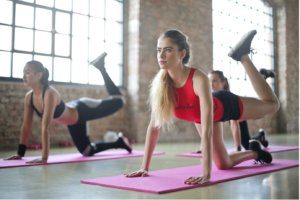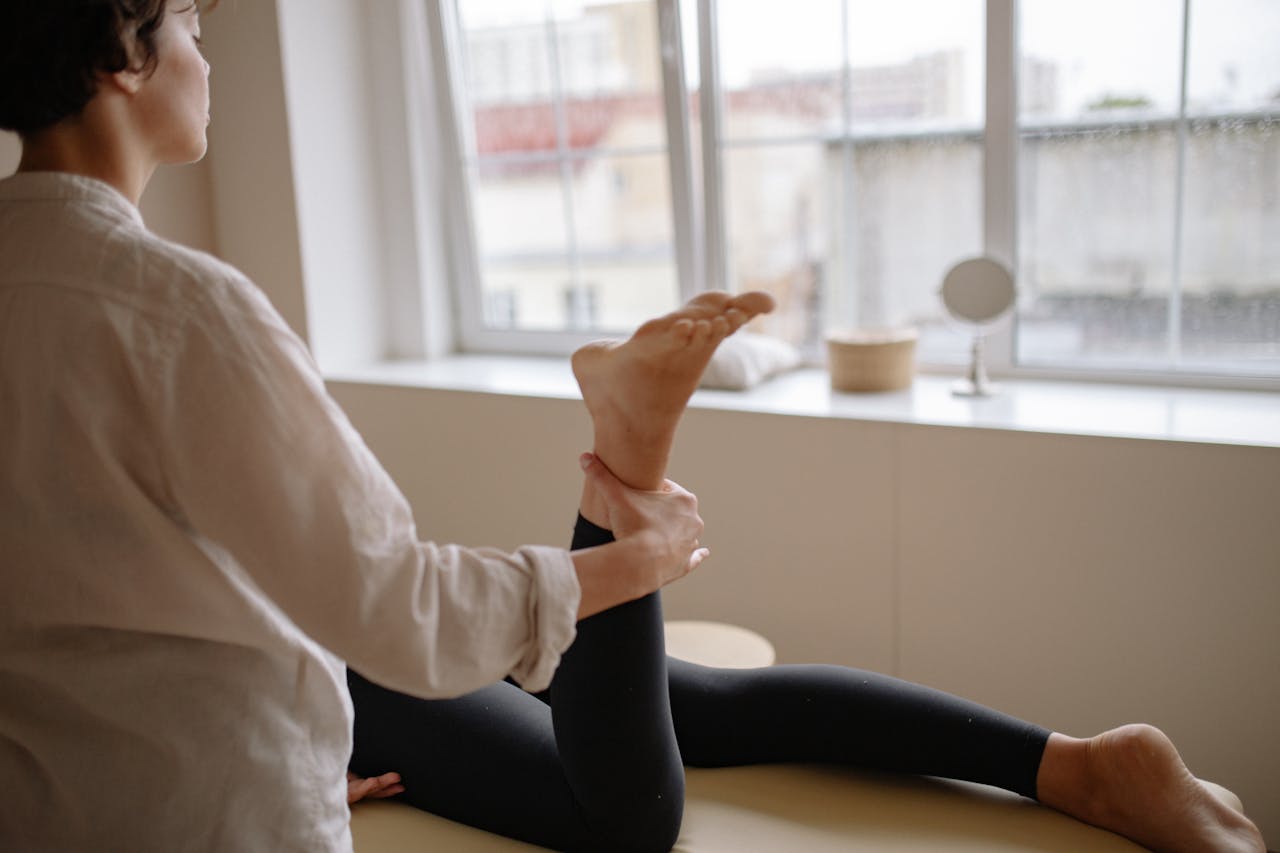What is Pilates?
Pilates is a style of workout developed by and named after its founder, Joseph Pilates. When creating the style back in the 1920’s he apparently drew from various disciplines including gymnastics, boxing and even Greco-roman wrestling! Luckily, you won’t actually find any of the latter two elements in any modern-day Pilates class. Nowadays the workout style is much calmer, placing a large emphasis on flexibility.

The Benefits of Pilates
As mentioned by the NHS, “Pilates has something to offer people of all ages and levels of ability and fitness,” and there are a bunch of benefits to be had through Pilates training. With that said, since Pilates is so popular it’s important for us to separate fact from fiction, as some Pilates practitioners have been known to exaggerate its potential benefits.
Benefits We Can Be Sure About
Core Strength and Endurance
Trust us, if you’ve ever been through a tough Pilates class you’ll have no doubt that Pilates is an incredible core workout.
Flexibility
Various stretches targeting your hips, quadriceps, inner thighs, hamstrings, calves, chest and shoulders mean that Pilates will definitely increase your flexibility over time.
Balance (Including Reduced Fall Risk)
Almost any physical activity that involves lots of different movement patterns will help to improve your balance, and Pilates is no exception. Research (Roller et al. 2018) has shown that regularly performing Pilates exercises resulted in reduced fall risk and significant improvements in balance in adults aged 65 and above.
Modest Strength Improvements
Pilates workouts use a combination of bodyweight and basic equipment to create some amount of resistance for your muscles and joints to work against, which can lead to modest strength increases in recreational (untrained) individuals.
However, if you’re a regular gym goer or exercise enthusiast, Pilates workouts won’t offer enough resistance to further improve your strength, so if that’s your goal your time might be better spent elsewhere.
Benefits We’re Not So Sure About
Weight Loss
Studies (Segal et al. 2004) have shown the Pilates on its own does not tend to produce any significant differences in weight or body composition. Realistically, weight loss is a complex process involving lots of factors, so this shouldn’t be surprising.
If weight loss is a goal then we recommend researching long term healthy eating and nutrition strategies. Here’s a great place to start.
Injury Risk Reduction
Injury risk is a complex discussion with a lot of factors at play. As of yet, there isn’t enough research to conclusively say that Pilates has any significant ability to reduce injury risk.
Is Pilates Right for Me?
Whether or not Pilates is right for you really depends on what your goals are. If you’re looking to improve your flexibility, core strength and general wellbeing then Pilates is a great choice. On the other hand, if you’re looking to run really fast, get really strong or build a lot of muscle then Pilates isn’t going to especially help you achieve those goals.
Overall, Pilates is great because of how accessible it is, you can be a complete beginner and still get a lot out of the class, or you can be a fairly experienced fitness enthusiast and still find a challenge. A good instructor will know how to vary the session to work for you.
Pilates Equipment
Pilates classes tend to divide into two types, equipment Pilates, in which you’ll need specific equipment (or most often the class will provide it) and mat Pilates, in which all you need is a floor mat.
For equipment classes, equipment includes the Reformer, Wunda Chair and Cadillac, which although confusingly named, are all essentially combinations of resistance bands attached to pulleys and straps in different positions, with the Cadillac adding on some extra trapeze style components.
For mat classes, most of what you’ll do is bodyweight based, although classes will also sometimes use simple equipment such as ankle weights, foam rollers and gym balls. This makes mat-based Pilates far more accessible for training at home or in smaller environments. Plus, NBC news even released a great piece all about how many equipment Pilates movements can be recreated with bodyweight at home.
How to Find the Right Pilates Class for You
First off, consider whether you want to try mat or equipment Pilates. If you’re someone who prefers bodyweight-based training and simplicity, then mat based is likely better for you.
Next, consider the type of teaching you want. You might want 1:1 instruction from a qualified coach, or you might prefer the motivation and social elements that come with classes. You should also think about whether you want the detail of in-person teaching, or the flexibility of online teaching to work around your schedule.
Third, consider the qualifications and experience of the teacher themselves, as well as their ability to make you feel calm, supported, and looked after. Remember, you’re paying this person to help you improve your fitness and feel better, so they should be up to the task.
Last but not least, consider location. You might have found the perfect class but if it’s 100 miles away it’s not going to be realistic to get there twice a week! We recommend spending some time on google, looking for local classes with good reviews.
You can try the Kemtai Pilates Studio and get real-time guidance and feedback at https://app.kemtai.com/studio
Frequently Asked Questions
Can I Injure Myself Doing Pilates?
Whilst any activity carries some risk of injury, the risk of injury in Pilates is incredibly small. Pilates doesn’t involve any jumping, running, sprinting or changes of direction, so it’s very low impact on your joints. What’s more, since the resistances you’ll be using are fairly small, there’s very little chance of injury to muscles or joints.
Generally speaking, the only real thing to be aware of is specific individual injuries or issues, for example if you’re recovering from a surgery. In those instances, its best to check with your GP first before starting a Pilates class.
What is the Difference Between Yoga and Pilates?
To be fair, both of the exercise styles have very similar methods, and both are good ways to improve balance and flexibility along with developing some modest strength. Both exercise styles also pay close attention to breathing and emphasise general wellness.
Overall, we would say that Yoga tends to put more emphasis on meditation practices, mindfulness and overall relaxation than Pilates, however since there are so many different styles and types of Yoga it can be hard to draw direct comparisons.
If you’re unsure, our best advice is just to try both and see which you prefer.
Summary
Pilates might have changed quite a bit from when it started it the 1920’s, but the overall theme of physical health and general wellbeing remains. Its main benefits include flexibility, core strength and endurance, and modest strength improvements, although claims to prevent injuries or increase weight loss are exaggerated. Classes can be equipment or mat-based, and you should consider the merits of each when choosing which class is right for you.
References / Further Reading
Margaret Roller, Aimie Kachingwe, Janna Beling, Dawn-Marie Ickes, Allyson Cabot, Gabrielle Shrier (2018) Pilates Reformer exercises for fall risk reduction in older adults: A randomized controlled trial, Journal of Bodywork and Movement Therapies, Volume 22, Issue 4, Pages 983-998.
NBC: https://www.nbcnews.com/better/lifestyle/reformer-pilates-what-it-who-it-s-best-how-do-ncna1094436
NHS: https://www.nhs.uk/live-well/exercise/guide-to-pilates/
Segal, Hein, Basford (2004) The effects of pilates training on flexibility and body composition: An observational study. Archives of Physical Medicine and Rehabilitation, Volume 85, Issue 12, Pages 1977-1981,

 7 min reading
7 min reading


